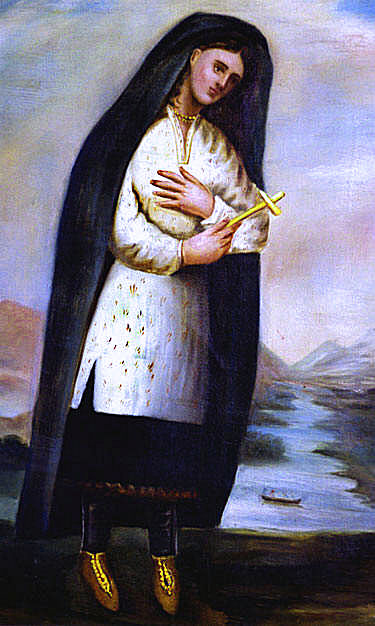10saint- holding
Saint Kateri Tekakwitha, the first Native American saint, was recently canonized by the Catholic church. Her canonization became official on Oct. 21, 330 years after her death.
Saint Kateri represents an estimated 600,000 Catholic Native Americans in the United States, a demographic which was previously unrepresented in the sainthood.
“It certainly gives the Native American community a saint and a model. If you look at the population, there’s a sychronistic attitude towards Catholiscsm, they’ve been able to infuse some of their traditions with that of the
In Santa Fe there’s a Native American festival and a mass. They bring in some of the languages and the dancing. What a Native American saint does is it integrates their spirituality with the Catholic faith,” said Father Lou Brussati, professor here at St. Edward’s.
Devotion to this new saint has in fact built a bridge between traditional Native American practices and Catholic ritual. The Tekakwitha Conference is held annually around the birthdate of Saint Kateri to commemorate her life and celebrate the faith. The festival includes Catholic practice mixed with cultural aspects such as dancing and music from the Mohawk people.
Saint Kateri was born in 1656 in a Mohawk Village in present day New York. She was orphaned at the age of four after her mother, who came from a Christian background, died of smallpox. It was during her teenage years that she devoted herself to the Catholic faith. She was ostracized for refusing to marry the man her uncle wanted her to marry. Kateri Tekakwitha faced much hardship for remaining steadfast in her faith. She moved to the Jesuit mission of Kahnawake in Canada to dedicate herself to the faith and seek refuge. There Kateri lived for four years and was noted for her dedication and intense desire to spread the message of her faith and her constant fasting and activities to prove her dedication. She died at the age of 24 due to health complications.
Saint Kateri is known as the “Lily of the Mohawks”. She is also remembered for her pledge to remain virginal until her death. She fasted and engaged in other intense acts to exhibit her faith and devotion. Her entire life she tended to be of poor health from contracting smallpox at the age of four which disfigured her face, rendered her eyesight poor, and killed her parents and brother. Accounts from other villagers paint her as a shy girl who was withdrawn from social activities.
After her death there were reports of people seeing her spirit. After this there were also different miracles accredited to her. In 1943, she was declared venerable, and in 1980 she was beatified.
On the day of her canonization Pope Benedict XVI referred to her as the “protectress of Canada”. He expressed hope that she would inspire faith and renew interest in the Catholic faith with the native people in North America. Other saints canonized that day were Father Jacques Berthieu, Anna Schaffer, and Sister Carmen Salles Barangueras.
“It’s a very interesting group of people. They tend to be simple and fairly ordinary kind of people who were living their lives in response to the gospel and were known for their simplicity and authenticity. All of them seem to be very much people who were interested in teaching the faith to others, they weren’t keeping it under a bushel basket,” said Father Brussati.
The abuse suffered by Native Americans in certain parts by those trying to forcibly convert them has not been forgotten. Some members of the Mohawk tribe see Tekawitha as merely an instrument of the destruction. The representation in the Catholic faith has been viewed as a reconciliation, as well as a belated acknowledgment to this significant population that lacks representation within the Church.







